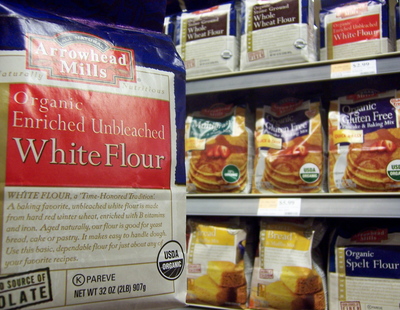Unbromated flour: please label
/
There is a time and a place for proper labeling. For example, California airports have placards telling travelers: "This area contains chemicals known to the State of California to cause cancer or birth defects." There you are, flying home, and unless you decide to tell your boss you are going to be 3 days late because you felt like taking a scenic rail trip over the Rockies, you do not have much of a choice but to stand there, looking at the sign, and wondering whether the carcinogens are in the carpet, the seats, the ceiling, or the duct system. Should you hold your breath until your plane boards? To me that labeling is helpful in the long run, but not while you are standing there.
Food labeling is helpful immediately. The more information about what you are putting into your body the healthier choices you can make. No one is ever going to force feed you an ice cream sundae. You choose to ingest those calories and sugar with your eyes wide open and sometimes the decadent nature of the treat can add to the pleasure of eating.
Which brings me to labeling unbromated flour.
Flour? Really?
Really.
Flour or gluten is in nearly everything we eat (just ask someone with Celiac Sprue disease). As a mainstay of our Western diet, it invites a closer inspection. The buzz words on the street for flour are "unbleached and unbromated." Most people I have asked do not know what bromation is.
I learned about bromation when I worked for Zingermans Bakehouse, if you already know the facts, please excuse me for this brief recap.
You harvest wheat and you grind it into flour, good. For the first couple of hours that flour can form beautiful gluten, which are protein strands that occur when you add mechanical energy, kneading, to flour and water. After those initial hours the enzymes go wonky in the flour and will not properly form gluten. However, if you age the flour for a few weeks or so it settles down enough to form gluten and baking can commence.
As we all know, time is money. Some smart person (there is a dearth of information about this on the internet) realized that if you pump potassium bromide onto the flour it artificially ages it. Therefore the flour can be used for baking without waiting for it to age. Voila! Money saved!
Meanwhile the UK banned the use of bromide in food products nearly 20 years ago, and Canada did the same thing 15 years ago. In 1986, California passed Prop 65 (ironically, the same rule that mandates the rule of carcinogen signs in airports) and many brands (like Pepperidge Farm, Arnold, Pillsbury, and Entenmanns) switched to an unbromated flour because otherwise their packages would need a cancer warning sign when sold in California.
There are very few flour labels that say unbromated, or "aged naturally." In my small sample size of reading ingredients in products made with flour (crackers, cereal, bread, pasta, etc), I could find no mention of unbromated flour. Unbleached flour was mentioned, enriched flour was mentioned, but there was nothing about unbromated.
Finally, I learned from a woman at the supermarket (curious as to why I was taking pictures of flour bags) that bromide is used to increase the density of vegetable oil, which then ends up in citrus flavored soft drinks (look for BVO in drinks like Mountain Dew).
I am not going to get into the science of whether or not bromide is a carcinogen. I want to know what I am putting into my body so I can choose with my eyes wide open. I would like bromated flour to be labeled.
Here is the article on annarbor.com.




